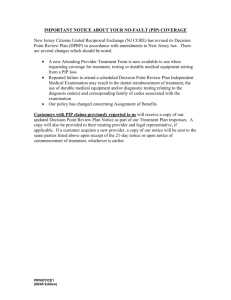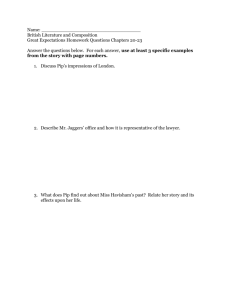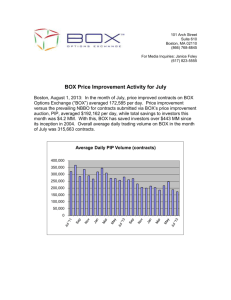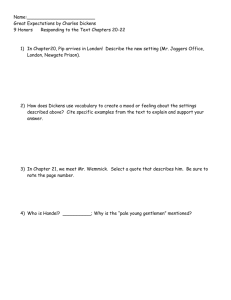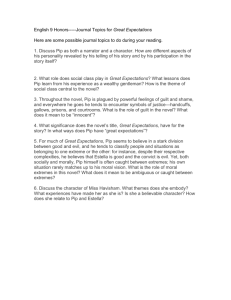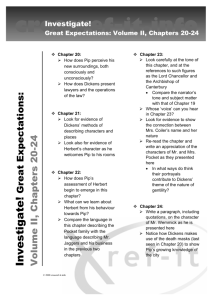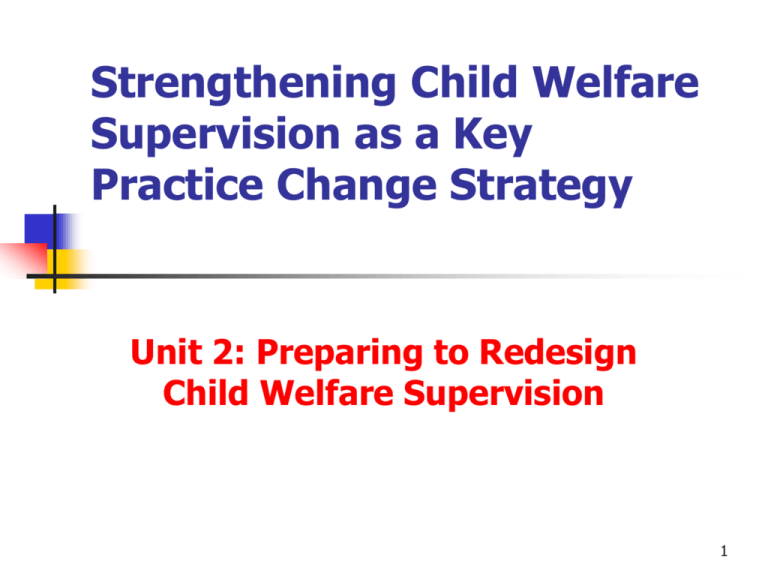
Strengthening Child Welfare
Supervision as a Key
Practice Change Strategy
Unit 2: Preparing to Redesign
Child Welfare Supervision
1
Results from Unit 1:
Helping Child Welfare Leaders
Re-conceptualize Supervision
2
Supervisors as Practice Change
Agents
• Provide clinical supervision
– Proactively direct the achievement of the
outcomes established by agency leaders
• Lead change
– Define what future practice should look like
– Align staff with that vision
– Inspire them to make it happen
3
Supervisors as Practice Change
Agents
• Why supervisors?
– Critical link between administrators and
frontline workers
– Highly visible role models for workers
– Give clinical direction that guides what
workers do with children and families
4
A New Role for Supervisors:
Practice Change Agent
Agency Leaders and Stakeholders
Define the mission, vision, values, and desired outcomes for the agency
Supervisors
Lead the change in practice to achieve those outcomes
Frontline Workers
Implement practice changes in a team with supervisor and coworkers
5
New Vision for Supervision
• The value and importance of supervisors to the
agency’s mission
• Leadership’s vision of the supervisor’s role and
responsibilities in achieving the agency’s
mission
• New practice change agent roles that will be
added or revised
– Use of Data
– Clinical Supervision
• Current roles that will be will be revised
• Current roles that will be removed
6
Charge for Planning Structure
• Role
– Develop a strategic plan to redesign supervision in
accordance with the vision just described
• Use of Data
• Clinical Supervision
• Duration
• Plan to Communicate with Leaders
– Method
– Frequency
• Supports from Leaders
7
Supervisors as Practice
Change Agents: Use of Data
Supervisor Involvement in the Child
and Family Services Reviews and
Program Improvement Plan
8
Overview
• CFSR
– Federal and State partnership for improving
outcomes for children and families
– First phase: Statewide Assessment
– Second phase: Onsite Review
- Conformity with requirements is determined
– Third Phase: PIP - Plan to address identified
areas needing improvement
9
Taking an Active Role
1. Participate in CFSR Statewide
Assessment
2. Participate in CFSR Onsite Review
3. Participate in PIP Development
10
1. Participate in CFSR Statewide
Assessment
•
Assess agency performance
–
–
•
•
•
7 outcome areas
7 systemic factors
Present changes in practice and performance
that resulted from PIP
Assess agency’s strengths and challenges
Identify issues and geographic locations for
further examination during onsite review
11
2. Participate in CFSR Onsite
Review
•
Gather information
– case file reviews
– case-related interviews with children,
parents, foster parents, caseworkers, and
other professionals involved with the child
•
•
Answer key questions about each case
Provide ratings to indicate strengths,
areas needing improvement, and levels
of outcome achievement
12
3. Participate in PIP Development
• Help interpret the CFSR results by region
or by office
• Identify practice or systems issues that
contribute to the problems
• Provide input into the creation of
strategies and action plans
• Help top management “reality-test”
reasons for the results and viable
strategies for improvement
13
1. Participate in CFSR Statewide
Assessment
• Statewide Assessment Instrument
– Section I
• General information about agency
– Section II
• Data profiles for safety and permanency outcomes
• Prepared by Administration for Children and
Families (ACF) based on AFCARS and NCANDS
data
• Provided to Statewide Assessment Team by ACF
14
1. Participate in CFSR Statewide
Assessment
• Statewide Assessment Instrument
– Section III
• Narrative assessment of state performance in 7
outcome areas
– Section IV
• Narrative assessment of state performance on 7
systemic factors
– Section V
• Assessment of state strengths and challenges
• Issues and geographic locations for further
examination during onsite review
15
1. Participate in CFSR Statewide
Assessment
• Statewide Assessment Instrument: Activity
– Review portion of previous statewide
assessment
– Consider how answers might be different in
next round
– If more information is necessary, determine
• What needs to be gathered
• Where it can be located
• Who can provide it
16
2. Participate in CFSR Onsite
Review
• Onsite Review Instrument
– Face Sheet
• General information about the agency, reviewer,
and case
– Section I: Safety (4 items)
– Section II: Permanency (12 items)
– Section III: Well-Being (7 items)
• All sections include a) questions and ratings for
each item and b) ratings for overall level of
outcome achievement
– Case Rating Summary
17
2. Participate in CFSR Onsite
Review
• Onsite Review Instrument: Activity
– Complete the CFSR excerpt using the case
provided
18
3. Participate in PIP Development
• Review CFSR Results
– Refer to handout for summary of your state’s
CFSR results
19
3. Participate in PIP Development
• Interpret CFSR Results: Activity
– Review data
– Interpret results
• Identify differences across locations
• Discuss possible reasons for differences
20
3. Participate in PIP Development
• Develop the PIP
1. General information with key contact information
2. A written work plan detailing the work to be
undertaken
•
•
a measurable goal of improvement, action steps, and
timeframe for addressing each outcome and systemic
factor that has been found not to be in substantial
conformity
a specific percentage of improvement (goal) that will be
achieved through the PIP for each statewide aggregate
data indicator that does not meet the national standards
21
3. Participate in PIP Development
• Develop the PIP
2. A written work plan detailing the work to be
undertaken
•
•
•
•
•
individual(s) responsible for undertaking each action
step
geographic areas of the state in which the action steps
will be undertaken
a plan for evaluating the implementation of the
provisions of the PIP, including benchmarks of progress
a plan for accessing technical assistance resources
a description of how PIP progress will be evaluated by
the state and reported to ACF
22
3. Participate in PIP Development
• Develop the PIP
3. An agreement form indicating approval of the PIP
by the ACF Regional Office and the State
4. A tracking matrix
•
•
summarizes the components of the PIP initially
permits tracking of progress and completion dates
through quarterly status reports
23
3. Participate in PIP Development
• Develop the PIP: Activity
– Refer to Section II: Strategies for
Developing the PIP
– How were supervisors involved in the PIP
after the last CFSR?
– How might supervisors be more involved in
the next PIP?
24
Supervisors as Practice
Change Agents: Use of Data
Supervisor Involvement in
Quality Assurance or
Continuous Quality Improvement
25
Overview
• Quality Assurance in the Past
– Traditionally focused on compliance with
state and federal requirements
– Paralleled federal approaches to
monitoring
26
Overview
• Quality Assurance Today
–
–
–
–
Assess practice and outcomes, in addition to
compliance
Attempt to use data, information, and results to
effect positive changes in policy and practice
Engage a broad range of internal and external
partners in the process (e.g., top managers, staff
at all levels, children and families served, and
other stakeholders)
Often referred to as Continuous Quality
Improvement (CQI)
27
Taking an Active Role
1.
2.
3.
4.
Serve as a reviewer
Interpret results of reviews
Review cases during supervision
Receive performance feedback
•
•
Prepare, access, or receive reports
Communicate with QA/CQI staff
28
1. Serve as a Reviewer
• Activity
– Review and rate the case provided using the
assigned section of your state’s review tool
– How was the experience of reviewing a
case?
– Do you have any particular reactions or new
insights?
– How might serving as a reviewer influence
how you supervise?
– Is this a practice change strategy the group
would consider recommending to the
agency?
29
2. Interpret Results of Reviews
• Steps in the Analytic Process
– Initial Identification—how are we
performing?
– Postulating and Hypothesizing—what
might explain this performance?
– Testing and Findings—of these factors,
what can be verified?
– Drawing Conclusions—what can we
conclude from these data?
Adapted from "Results Oriented
Management" 2002 U. of Kansas
30
2. Interpret Results of Reviews
• Step 1: Initial identification—how are we
performing?
– What is the unit or agency’s level of
performance?
– Is the performance meeting an established
standard?
– How does the performance compare to other
management units?
– Has performance changed over time?
Adapted from "Results Oriented
Management" 2002 U. of Kansas
31
2. Interpret Results of Reviews
TRUE OR FALSE?
1.
The outcome "Reunification in less than 12 months” is
consistently being met.
2.
The outcome "Reunification in less than 12 months" has
improved in the last six months.
3.
The outcome "Reunification in less than 12 months"
shows improvement, but the number of reunifications has
fallen off over the year.
4.
Performance on the outcome "Reunification in less than
12 months" is so good that there should be an agencywide celebration.
Adapted from "Results Oriented
Management" 2002 U. of Kansas
32
2. Interpret Results of Reviews
TRUE OR FALSE?
5.
The outcome "Reunification in less than 12 months" is
being achieved by all areas but Area V.
6.
The outcome "Reunification in less than 12 months" is so
high in Area II that someone ought to find out what Area II
is doing so well.
7.
The outcome "Reunification in less than 12 months” is
good in Area 1, but one would wonder why this area has
reunified so few children compared with other areas.
Adapted from "Results Oriented
Management" 2002 U. of Kansas
33
2. Interpret Results of Reviews
• Step 2: Postulating and hypothesizing
– What factors might explain this performance?
• Client factors
• Services factors
• Organizational factors
• Community factors
Adapted from "Results Oriented
Management" 2002 U. of Kansas
34
2. Interpret Results of Reviews
• Step 3: Testing and findings—what can be
verified?
– Three main information sources
• Reports systems and data bases
• Collective brain trust
• Case records (files)
– Verifying relationships requires comparisons
between groups on outcomes
• Only compare mutually exclusive subpopulations
Adapted from "Results Oriented
Management" 2002 U. of Kansas
35
Adapted from "Results Oriented
Management" 2002 U. of Kansas
36
Child Characteristic
Reunification in less than 12
months
15
Children with disabilities
10%
Non-minority children
(white)
359
68%
Is it fair to conclude that the unit is doing a
better job of reuniting white children than
children with disabilities?
Adapted from "Results Oriented
Management" 2002 U. of Kansas
37
Developing Hypotheses
Adapted from "Results Oriented
Management" 2002 U. of Kansas
38
2. Interpret Results of Reviews
• Step 3: Testing and findings—what can be
verified?
– Hypothesis Example 1
• Do children whose visitation requirements
were met achieve reunification in less than
12 months more often than those children
for whom visitation requirements were not
met?
• Focuses on the Services Factor (visitation)
Adapted from "Results Oriented
Management" 2002 U. of Kansas
39
2. Interpret Results of Reviews
• Step 3: Testing and findings—what can be
verified?
– Hypothesis Example 2
• Do children who are neglected get reunified
in less than 12 months more often than
those children referred for other types of
abuse?
• Focuses on the Client Factor (referral type)
Adapted from "Results Oriented
Management" 2002 U. of Kansas
40
2. Interpret Results of Reviews
• Step 3: Testing and findings—what can be
verified?
– What is it about Factor X that is influencing
performance?
– Analyze data to isolate and confirm that
certain factors appear to affect an outcome
– But, it might be something else…..
– Be sure to consider alternative explanations,
but know when to stop
Adapted from "Results Oriented
Management" 2002 U. of Kansas
41
2. Interpret Results of Reviews
• Step 4: Drawing conclusions
– Develop the most plausible explanation and
draw your conclusion about how best to take
action
– Avoid making statements about causation on
the basis of just observing a correlation
(association)
Adapted from "Results Oriented
Management" 2002 U. of Kansas
42
2. Interpret Results of Reviews
• Activity
– Sue’s Case Scenario
– Identify performance problem
– Practice 4 steps of analytic process
– Learn how the problem was resolved
Adapted from "Results Oriented
Management" 2002 U. of Kansas
43
3. Review Cases During Supervision
• Supervisory Case Review Tool
– Based on CFSR
– Used to help workers improve practice by
learning the connections between case
practice and outcomes
– Used to review 1 case per worker per
quarter
44
3. Review Cases During Supervision
• Supervisory Case Review Tool
– Questions to consider
•
•
•
•
What is your initial reaction to this type of
tool?
What are the anticipated advantages or
disadvantages of supervisor use of this type
of tool?
How might using a tool like this influence how
you supervise?
Is this a practice change strategy the group
would consider recommending to the agency?
45
4. Receive Performance Feedback
Copyright © 2003 University of
Kansas School of Social Welfare. All
rights reserved. Used with permission.
46
4. Receive Performance Feedback
• Relevant
– Aggregated for your management unit
– Timely
• Easy
– Easy to read
– Provide trends
– Measure percentages
– Provide comparisons
47
4. Receive Performance Feedback
• Stresses Outcomes
– Emphasize outcomes through report design
– Show progress toward outcome
achievement
• Utility
– Identify cases
– Drill down for analysis
48
4. Receive Performance Feedback
• Lean
– Fewer Reports
– Data Summarized
• Trustworthy
– Accurate
– Verifiable
• Standards
– Draw standard lines on graphs
– Show the extent over or under
49
4. Receive Performance Feedback
• Activity
– Complete survey to evaluate the quality of
existing management reports
– Share responses
– Discuss
• What types of changes will need to be made to the
management report system?
• What existing reports are helpful?
• What existing reports should be modified?
• What types of reports do not currently exist that would be
helpful?
50
Supervisors as Practice Change
Agents: Clinical Supervision
51
Clinical Supervision Expectations
and Practice
•
•
•
•
Establishing expectations
Expectations in another state
Clinical case review example
How might clinical supervision look in your
agency?
52
Using Data and Supervision to
Change Practice
53
Using Data and Supervision to
Change Practice
• Knowledge of Data + Clinical Supervision
= Practice Change
• Action Menu
–
–
–
–
–
–
Individual cases (clinical supervision)
Agency systems
Key collaborations
Staff capacity
Resources
Rewards
54
Activity 1
•
•
•
•
CFSR Outcomes and Items
CFSR Questions
SACWIS Field or Report
Supervisor Actions or Directions
55
Activity 1
•
•
•
•
Select an outcome and item from handout
Read associated CFSR questions
Identify relevant SACWIS fields or reports
Generate possible supervisory actions or
directions that can improve outcomes
• Rotate worksheets across groups and add to
columns 3 and 4
• Share most promising or innovative ideas
56
Activity 2
• Read assigned scenarios
• Answer associated questions
• Report answers to large group
57
Motivating Staff to Change
Practice
58
A New Role for Supervisors:
Practice Change Agent
Agency Leaders and Stakeholders
Define the mission, vision, values, and desired outcomes for the agency
Supervisors
Lead the change in practice to achieve those outcomes
Frontline Workers
Implement practice changes in a team with supervisor and coworkers
59
Resistance
•
•
•
•
•
•
Feelings of loss of control
Fear of failure
Uncertainty about the future
Negative experiences with past changes
Possible need for more effort and work
Little or no warning of impending change
60
Building Commitment
• Build a shared sense of the future by
communicating the vision and strategies
–
–
–
–
–
Keep message simple
Convey a sense of urgency
Use multiple means of communication
Repeat the message
Listen, answer questions, and solicit
feedback
– Explain apparent inconsistencies
61
Building Commitment
• Serve as a role model and lead by
example
• Involve workers and reinforce their role in
achieving outcomes
• Remove barriers and provide supports
• Recognize and reward successful change,
without undermining momentum
62
Activity
• Think about a time you implemented (or tried to
implement) a practice change that required
acceptance and commitment from staff
• Briefly share your experiences with one another
and select one past experience for the group to
focus on for the purpose of the exercise
• Evaluate the practice change by answering the
handout questions
63
The Strategic Planning
Process
64
Four Primary Steps
1.
2.
3.
4.
Preparation
Development
Implementation
Revision
65
1. Preparation
• Vision: the ideal future image of
supervision
• Mission: the purpose of supervision in the
agency
• Guiding principles, values, and beliefs: the
standards and ideals that guide
supervision
66
2. Development
1. Assess current reality of the agency
2. Prioritize needs, strengths, and
resources
3. Address five key questions
– What do we want to accomplish?
– What we will do to get there?
– How will we know if we are making
progress?
– Who will be responsible?
– What is the time frame for completion?
67
3. Implementation
• Strategic plan is communicated and
implemented
• Progress is monitored and reported
68
4. Revision
• Progress is reviewed and the plan is
revised as needed
• All steps are reassessed, and updates are
made when necessary
69
Next Steps and Work Plan
• Strategic planning step
• Tasks to be accomplished
• Meeting date and time
– It is recommended that the group plan to
follow up with agency leaders after every
meeting to inform them of progress and
recommendations
70

